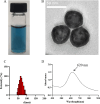Effects on molecular interactions of hollow gold nanoparticles and antibody for sensitizing P24 antigen determination
- PMID: 39315032
- PMCID: PMC11418390
- DOI: 10.1039/d4ra05277c
Effects on molecular interactions of hollow gold nanoparticles and antibody for sensitizing P24 antigen determination
Abstract
In recent years, with the rapid development of point-of-care testing, the application of lateral flow immunochromatography assay (LFIA) has become increasingly widespread. The key to the success of these detection technologies is the effective binding with diagnostic materials and detection antibody proteins. Although many researchers have tried to optimize antibody binding, a universally accepted strategy that can provide maximum performance has not been determined. In this study, the HIV infection P24 antigen was selected as the detection biomarker. Then the binding mechanism between hollow gold nanoparticles as diagnostic materials and detection antibodies was explored through dynamic light scattering, Fourier transform infrared spectroscopy, circular dichroism spectroscopy, and other methods. It was found that the binding efficiency is related to the change in protein secondary conformation during binding, hydrogen bonding, and van der Waals force maintain the binding mechanism between antibodies and nanoparticles. The main forces of particle complexation and the main binding site of the antibody were discussed and analyzed. Finally, an immunochromatographic system was constructed to evaluate the significant advantages of this platform compared to the common colloidal gold immunochromatographic system.
This journal is © The Royal Society of Chemistry.
Conflict of interest statement
The authors declare no conflict of interest.
Figures







Similar articles
-
Development of Monoclonal Antibodies against HIV-1 p24 Protein and Its Application in Colloidal Gold Immunochromatographic Assay for HIV-1 Detection.Biomed Res Int. 2016;2016:6743904. doi: 10.1155/2016/6743904. Epub 2016 Mar 16. Biomed Res Int. 2016. PMID: 27069923 Free PMC article.
-
To reveal the nature of interactions of human hemoglobin with gold nanoparticles having two different morphologies (sphere and star-shaped) by using various spectroscopic techniques.J Photochem Photobiol B. 2018 Jan;178:355-366. doi: 10.1016/j.jphotobiol.2017.11.026. Epub 2017 Nov 22. J Photochem Photobiol B. 2018. PMID: 29182925
-
Development of colloidal gold-based immunochromatographic assay for rapid detection of Mycoplasma suis in porcine plasma.Biosens Bioelectron. 2014 May 15;55:396-9. doi: 10.1016/j.bios.2013.12.048. Epub 2013 Dec 31. Biosens Bioelectron. 2014. PMID: 24434494
-
Sensitization Strategies of Lateral Flow Immunochromatography for Gold Modified Nanomaterials in Biosensor Development.Int J Nanomedicine. 2023 Dec 21;18:7847-7863. doi: 10.2147/IJN.S436379. eCollection 2023. Int J Nanomedicine. 2023. PMID: 38146466 Free PMC article. Review.
-
More reliable diagnosis of infection with human immunodeficiency virus type 1 (HIV-1) by detection of antibody IgGs to pol and gag proteins of HIV-1 and p24 antigen of HIV-1 in urine, saliva, and/or serum with highly sensitive and specific enzyme immunoassay (immune complex transfer enzyme immunoassay): a review.J Clin Lab Anal. 1997;11(5):267-86. doi: 10.1002/(SICI)1098-2825(1997)11:5<267::AID-JCLA5>3.0.CO;2-4. J Clin Lab Anal. 1997. PMID: 9292394 Free PMC article. Review.
References
-
- O’farrell B. Lateral Flow Immunoassay Systems: Evolution from the Current State of the Art to the Next Generation of Highly Sensitive, Quantitative Rapid Assays. Immunoassay Handb. 2013;89:89–107.
LinkOut - more resources
Full Text Sources

